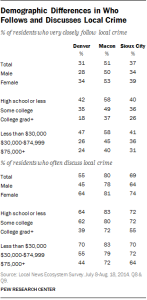A major new Pew Research Center study projects the changing size and distribution of religious groups around the world in the coming decades. (Some of the key findings can be seen here.) The study uses thousands of sources of data from countries around the world on fertility, age composition and other demographic factors to predict the globe’s religious demography out to 2050.

Fact Tank sat down with Conrad Hackett, the report’s primary researcher, to discuss how he and his team put the report together and why it is different from past efforts to predict religious change.
What was your main goal in undertaking this project?
Years ago, we realized that no one was using the best tools of social science to estimate the current and future size of global religious populations. We saw this as an area where Pew Research could break new ground, so we hatched a plan to measure the religious demographics of every country.
Given the enormity and expense of the task, we decided to do this project in steps. With funding from The Pew Charitable Trusts and the John Templeton Foundation, we first worked to provide a reliable estimate of the global Muslim population and then to project Muslim populations to the year 2030. Next, we reported on the size and distribution of the global Christian population. We followed these reports with an overview of the religious landscape in every country of the world as of the year 2010. We also reported on the religious identity of migrants around the world. With all these reports under our belt, we were ready to project the size of religious groups in every country out to the year 2050.
Did the Pew Research Center survey the entire world to come up with these projections?
No. We relied on more than 2,500 data sources, including censuses, demographic surveys, general population surveys and other studies. Census data in many countries are extremely helpful: We know the religious composition of 45% of the world’s people due primarily to censuses that measure religion. However, many countries, such as the United States, do not measure religion in the census and, in such cases, we used the best available alternatives, including, in many cases, Pew Research survey data.
These primary sources – censuses and surveys – were used to estimate the religious makeup of countries as of 2010, and also to measure fertility and age differences among religious groups. We also relied on data from the United Nations World Population Prospects report to model future country-level fertility and mortality patterns.
Prior predictions about the future of religion have been criticized for ultimately being inaccurate. What makes the estimates in this report different?
There is a long history of people predicting the demise of religion, but religion has proven more resilient than many people anticipated. Prior predictions were rooted in theories about social change rather than demographic data. For instance, some social scientists argued that people would move away from religion as they encountered religions different from their own, or as they achieved economic security or as they became more educated.
Our projections are not based on a theory about how religious identity will change in the future. Instead, we apply the scientific tools of demography to understand how the world’s religious composition is expected to change in the future if current trends continue. Demographers have a strong track record of modeling population change. We used these tools to anticipate future change in the religious landscape. For example, we determined that Muslims have more children per woman than any other major religious group and they also have a younger population than any other group. Consequently, we project Muslims will grow faster than any other group in the coming decades.
What were the biggest challenges in putting together this study?
Collecting and standardizing the data from thousands of sources was a huge undertaking. We also were presented with specific methodological challenges, including figuring out how to model religious switching, addressing data shortcomings in China and other countries and taking into account the effect of migration between countries.
Projecting migration flows proved particularly challenging. It is difficult even to accurately estimate recent migration flows, in part because data is usually only collected for one direction of migration – people moving into a country. Projecting complete migration patterns required new, sophisticated methods.
In addition, it’s often hard to know the religious identity of migrants, since many governments don’t gather such data. Furthermore, we can’t get around that problem by just assuming that immigrant groups share the religious composition of the population of their home country. For example, although 95% of Egyptians identify as Muslim, Egyptian-born people living in the United States are disproportionately Christian.
In the report, you single out China as a source of concern. What problems did data on China pose and how did you work around them?
China has the largest population in the world and, as a result, has a huge impact on global trends. At the same time, religion remains a sensitive topic in China and consequently, it is difficult even to get accurate estimates of the country’s current religious composition. For example, in a 2007 survey, about 3% of respondents identified as Christian. However, there is reason to believe that Christian identity was underreported by those connected to the Communist Party as well as by people who attend churches that are not officially recognized by the Chinese government. Taking into account such measurement challenges and considering evidence from additional sources, we estimate that about 5% of China’s population was Christian in 2010.
Some observers, including Purdue University sociologist Fenggang Yang, claim that, due to religious switching, Christianity in China is rapidly growing. Although we don’t have reliable enough data to model religious switching in China, we discuss various potential scenarios in the report to indicate how different both China’s and the world’s religious composition could be in 2050, depending on levels of religious switching in China.


